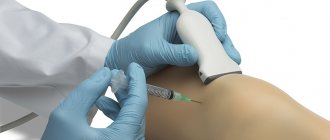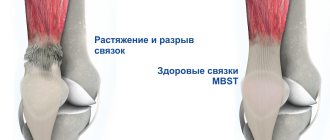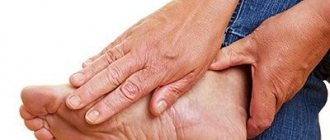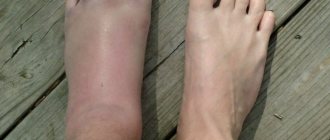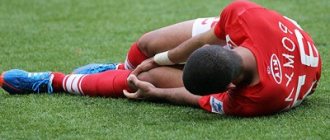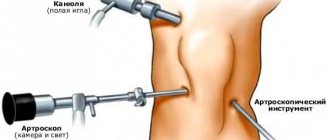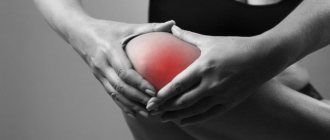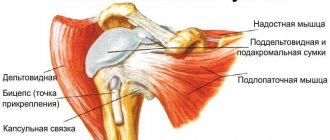In most cases, ligament rupture at the ankle joint does not require surgical treatment. After a 2-week period of immobilization in an orthotic bandage and 4 weeks of physical therapy aimed at strengthening the lower leg muscles and developing muscle balance, in 90% of cases nothing bothers the patient.
But we are interested in the fate of those 10% who develop instability after a ruptured ankle ligament. Almost always, these patients receive the same conservative treatment as others, the symptoms become less severe, but do not go away completely. In such cases, you should seek surgical help, as the consequences of instability in the ankle joint can be very serious.
Rehabilitation program after ligament rupture
As an example, we take an average rehabilitation course in terms of duration and content, which in fact can vary on an individual basis, both up and down.
| Services list | Price |
| 1 initial consultation with a doctor | 1 600 |
| 3 repeated consultations with a doctor as part of the course of treatment | for free |
| 10 Hivamat-therapy procedures | 22 000 |
| 10 acupuncture procedures | 27 000 |
| 5 PRP treatments | 35 000 |
| 5 kinesitis taping procedures | 8 000 |
| 7 classes on decompression simulators with an instructor | 18 900 |
Total*: RUB 112,500 (price with 10% discount for one-time payment of the full course RUB 101,250)
Course duration is 3-4 weeks.
* The cost of the rehabilitation course does not include tests and examinations. If you have already taken them, you can bring the results with you to your initial appointment with the doctor.
You can also take advantage of an additional 25% discount on procedures on the day of your initial appointment.
Contact us
Call now
8 (495) 803-27-45
Make an appointment through our service
Make an appointment
Causes and degrees of ligament rupture
Mechanical destruction of the connective tissue bundles that hold articular cartilage together can be caused by injury or degenerative processes. This leads to muscle swelling and loss of limb mobility.
In treatment and rehabilitation, ligament ruptures are divided into three degrees:
- Tensile or local micro-fractures.
- Multiple micro-tears leading to partial loss of functionality of the ligamentous apparatus.
- Complete rupture with loss of functionality (surgery required).
Most often, patients with injuries to the knee, ankle, foot, collarbone, shoulder, and elbow seek treatment and rehabilitation after ligament rupture.
The weakening of connective tissue fibers occurs with age, as well as due to deterioration of muscle blood circulation due to physical inactivity. Athletes and people whose work involves lifting weights often need rehabilitation after a ligament rupture.
Clinical case of ankle ligament rupture.
Patient Ch., 23 years old, injured while playing football, turned his right foot outward during a sharp push, heard a crunch, felt a sharp pain. He went to the emergency room, where x-rays were taken without weight-bearing, immobilization in an orthotic bandage for 2 weeks and conservative treatment were recommended. Considering the lack of positive dynamics, I decided to seek a consultation at the K+31 clinic.
History of repeated ankle injuries. For a long time (more than 3 years) on the right ankle joint.
3-4 times a year there were episodes of “tucking” of the ankle joint inwards, after which swelling in the area of the outer ankle and pain when walking were noted for 1-2 weeks. He was treated conservatively, fixation with an elastic bandage, cold, topical diclofenac ointment; during this treatment, he noted a gradual regression of edema and restoration of a painless range of motion.
The latest football injury caused an increased feeling of instability, and the swelling was more pronounced. The lack of positive dynamics forced the patient to consult a doctor.
In our clinic, patient Ch. Was examined by a doctor, damage to the distal tibiofibular syndesmosis was suspected, due to chronic instability of the ankle joint. An MRI of the ankle joint and a standing radiography of the ankle joints with body weight loading were performed, as well as stress radiographs in a forced position, which confirmed the diagnosis.
Below are MRI sections that clearly show the location of damaged ligamentous structures.
In almost 100% of cases, these injuries are missed during the initial visit to the emergency room. If untimely or inadequate treatment is used, instability of the ankle joint leads to destruction of the articular cartilage, severe pain, deformation, and ultimately to complete loss of the function of support and walking. Depending on which ligaments are torn and on how pronounced the instability is, arthrosis develops in different periods, from 1 year with a rupture of the syndesmosis, to 20 or more years with an isolated rupture of the anterior talofibular ligament.
It is very important that during the initial visit to the emergency room, patients with damage to the ligamentous apparatus of the ankle joint are given full radiographs, standing with body weight, an oblique projection with internal rotation of the leg of 15 degrees, and, if necessary, stress radiographs.
A detailed study of the images reveals an increase in the tibiofibular gap to 7.5 mm, a decrease in the area of overlap of the tibia and fibula to 5 mm, and the absence of overlap of the shadow of the talus and fibula on the affected side.
On the x-ray of the bones of the right and left ankle joints in a direct projection, standing photographs - on the right, signs of damage to the distal tibiofibular syndesmosis are determined - the degree of mutual overlap of the tibia bones is 5 mm (normally more than 6mm), enlarged tibial-fibular space - 7.5mm (normally up to 6mm).
When performing stress radiographs, pronounced lateral instability of the ankle joint is determined.
This patient also had excessive mobility of the fibula at the level of the distal tibiofibular syndesmosis with compression of the tibia at the level of the middle third, which was clinically manifested by pain along the anterior edge of the lateral malleolus.
Considering his young age, desire to actively engage in sports, and anamnestic data indicating chronic instability of the right ankle joint, a decision was made on surgical treatment.
Below are the stages of surgical treatment.
After restoration of the lateral ligamentous complex according to Brostrom in Gold's modification and fixation of the tibiofibular syndesmosis with a screw, the stability of the ankle joint is assessed using a valgus stress test under the control of an image intensifier.
Hypermobility of the ankle joint is eliminated, the position of the talus remains unchanged despite the application of valgus load.
This is followed by layer-by-layer suturing of the wound and application of a plaster cast.
Clinical manifestations
In the field of treatment and rehabilitation, the following symptoms are identified that appear when ligaments are torn:
- pain syndrome (connective tissue has many pain receptors, so when it is damaged, sharp acute pain occurs);
- edema (traumatic inflammation leads to increased permeability of the vascular walls, which causes the release of the liquid component of the blood into the soft tissues);
- hematoma (a bruise occurs due to rupture of blood vessels; with severe hemorrhage, the affected area may increase in volume, the skin becomes hot);
- limitation of mobility (due to a violation of the integrity of the ligamentous apparatus and pain, the joint cannot fully function).
Ligament rupture
Ligament rupture | Reasons | Symptoms | First aid | Treatment |
Sprained or torn ligaments are not only the lot of athletes, but also a common household injury. The articular-ligamentous apparatus is not always ready to be tested under increased loads. Even an ordinary walk can result in a ruptured joint ligament. In order not to fall out of the active rhythm for a long time, do not self-medicate, seek professional medical help!
Sign up
Ligaments are sections of connective tissue that connect joints and help them move safely along a given path. The ligaments are elastic, strong and reliable. If you use them “according to the instructions”: carefully, with moderate loads. Careless movements, as well as internal degenerative processes, lead to damage, premature wear and even rupture of ligaments, most often in the arms and legs.
Immediately after an injury, it is difficult to understand what happened: signs of ligament rupture in the first hours can easily be confused with a bruise or dislocation. Therefore, you need to go to the emergency room as soon as possible. The traumatologist will determine how serious the injury is and provide first aid. Early treatment of a joint ligament rupture helps to avoid surgery in 80% of cases and shorten the recovery period.
Ask a Question
BREAKING LIGAMENTS: REASONS
External factors:
- a fall;
- sharp blow;
- squeezing.
Injuries occur not only in extreme conditions (sports training, accidents, fights).
The risk of getting a sprained or torn ligament increases significantly if you have:
- systemic and congenital connective tissue diseases;
- persistent infections;
- hormonal disorders;
- excess weight;
- diabetes;
- muscle weakness;
- pathologies of the skeletal structure (scoliosis, flat feet) disrupt posture and gait, which causes the load on the ligamentous apparatus to increase many times over.
Expert opinion
Commented by Ubin I., chief physician of the Doctor Ost MC in Perm, traumatologist-orthopedist, chiropractor. According to statistics, in 90% of cases, ligament rupture occurs due to degenerative processes. When the articular-ligamentous system is weakened and exhausted, injury can happen, as they say, “out of the blue.” and if the patient is at risk and has previously experienced such a misfortune, care should be taken to ensure that the ligament does not rupture again. The best prevention in this case will be modern technologies of restorative medicine. These are PRP and SVF therapy. In both cases, the patient’s biomaterial is specially prepared, that is, we are talking about autoimmune treatment. The patient is cured using the body's own reserves. Only this happens much faster since growth factors and stromal cells are delivered in high concentration directly to the affected area. In this way, it is possible to nourish the articular-ligamentous apparatus, making it more resilient and elastic, as it should be normally. Then the story “I accidentally tripped and woke up in a hospital bed” will no longer be about you! Strong ligaments securely fix the joint and keep you on your feet! Take care of your health in a timely manner and be healthy!
Make an appointment
SYMPTOMS OF RUPTURED LIGAMENTS
The ligaments of the ankle, knee, elbow and shoulder joints are especially often affected. The symptoms are similar:
- sharp, incessant pain, the damaged limb cannot be used;
- joint swelling;
- change in skin color over the tear: bluishness or redness, hematoma;
- local increase in temperature;
- when, some time after the ligament ruptures, the pain subsides, unusual mobility is detected in the joint: it becomes unstable.
FIRST AID FOR RUPTURED LIGAMENTS: REMINDER
- Do not load the damaged joint, provide it with complete rest.
- Apply cold.
- Go to the emergency room. Only a doctor knows and can assess the extent of the injury. It is extremely important to immobilize the joint. In emergency rooms, plaster casting is traditionally used for this purpose. Later, the plaster can be replaced with a modern, more comfortable analogue - orthotics, and in mild forms or at the final stage of treatment - with taping.
If a professional does not intervene in the healing process, there is a risk of partially losing the mobility of the limb. In the future, chronic ligament rupture that has not received proper treatment will result in chronic pain, early development of osteoarthritis and, ultimately, the need to install a prosthesis.
TREATMENT OF RUPTURED LIGAMENTS
First aid has been provided. How to treat a torn ligament further? It makes sense to go to a clinic and undergo physical therapy. They will help to most effectively and quickly relieve the consequences of injury: hematoma, swelling, pain and inflammation.
If the ligament rupture is significant and diagnosis using X-ray or MRI is not enough, arthroscopy is performed - although it is minimally invasive, it is still an operation. With the help of an arthroscope you can:
- examine the joint from the inside;
- reconstruct the ligament or remove its fragments;
- apply the medicine to the affected area.
Expert opinion
Selyunin A.V., a specialist in physical rehabilitation, comments. Patients are concerned about how long it will take for ligament ruptures to heal after arthroscopy.
In fact, 90% of the speed of healing depends on themselves, on the strict adherence to the postoperative regimen. If there were no complications, the joint will take 1.5-2 months to heal after arthroplasty. Complete restoration of the damaged ligament is achieved after 4-6 months. But even by this time, the treatment of the joint, one might say, is just beginning! Rehabilitation awaits. Gradually, you need to put a load on the joint, accustom the patient to walking independently without a cane. At this stage, classes with rehabilitators will come in handy. MC Doctor Ost in Chelyabinsk is ready to offer individual classes on kinesiosimulators with biological feedback under the compulsory medical insurance policy. During rehabilitation, it is important to monitor and prevent attempts to compensate for weakened muscle groups with other muscle groups. And this is fraught with consequences: distorted motor stereotypes slowly but surely destroy the musculoskeletal system and trigger the development of new diseases: arthrosis, protrusions, intervertebral hernias. Make an appointment How long ligament ruptures heal, of course, depends on many factors: the severity of the injury, the age of the patient and the techniques that the doctor was able to offer.
However, now in most cases it is not necessary to open the joint using an arthroscope!
Advanced cellular technologies at the Doctor Ost Medical Center make it possible to cure a patient from the consequences of injury, including rupture of ligaments and tendons, without surgery or postoperative rehabilitation. SVF therapy stimulates natural regeneration processes, and instead of drugs, it uses a concentrate of stromal cells and growth factors prepared from the patient’s own biomaterial. Our patients have already appreciated the capabilities of this innovative technique.
how much does it cost? A traumatologist treats ligament ruptures at Doctor Ost. Find the cost of a specialist consultation in the “Consultative Appointment” section of our price list. Follow the promotions, don't miss out on the best price!
Features of ligament injuries
Such injuries are extremely painful and are divided into several types depending on the severity of the injuries:
- Microfractures . They are classified as mild injuries and do not require specific treatment measures. Mild sprains go away on their own.
- Partial . There is a significant decrease in the functionality of the damaged joint, but with preservation of performance. The person feels mild pain and maintains the reaction of the joint tissue.
- Full . Significant injuries that occur with the formation of large-scale hematomas and complete loss of activity.
If the recovery processes for grade I and II injuries take 2-14 days, then a serious problem requires more strength and an individual approach.
Got it: how to restore ligaments after training
Damage to ligaments (sprain, or even rupture) is a problem that is familiar firsthand to almost everyone who has ever played sports. Failure to follow the technique, poor stretching, careless approach to warming up - and sharp pain signals a serious injury. How to return to normal life after treatment? The story is told by professional coach and athlete Valery Babich.
Source: Instagram.com
Read also: Don’t delay: we treat muscles and ligaments
We believe that you should definitely visit a doctor in such unfortunate cases. You follow all his recommendations, undergo thorough treatment and now dream of quickly returning to normal life and your favorite exercises. Scary? A few coaching tips will help you get through the adjustment period without too much anxiety.
What are ligaments?
Ligaments and tendons are fibers, like ropes, that hold your bones in a position “assembled” into a skeleton, preventing joints from dangling, and performing a motor function. Simply put, the skeleton is connected by veins like ropes. Rupture and damage to part of this mechanism leads to limited mobility and sometimes has very unpleasant consequences. This injury simply cannot be treated with disdain.
Need some peace
Read also: Don’t take risks: TOP 10 mistakes with kettlebells
Keep in mind that you have absolutely nowhere to rush. The rehabilitation period will last at least two months, depending on the severity of the injury. The best thing you can do is to give the damaged area rest for as long as possible. If there is such a possibility, then a week or ten days, even with a minor injury, will give a better result than starting loads almost immediately. As in the case of a fracture, this is not the moment when you should immediately start jumping vigorously. Allow the damaged vein to heal properly.
Source: depositphotos.com
Watch your technique
Everyone knows the feeling of fear while driving after an accident. The same thing will happen when you return to the gym. Therefore, the first thing you need to do is make sure that the instinctive desire to protect the damaged area does not prevent you from following the technique of doing the exercises to the highest standard. You simply have to do it: the rules were not invented by idiots, they were written in blood and, unfortunately, you were convinced of this too.
Source: depositphotos.com
Practical advice
Read also: Knee pain: what will it lead to in the future?
- Begin recovery gradually, warming up without weights, and perform the exercises included in the warm-up complexes.
- Warm up and stretch well before your workout, but be careful. Do not approach this carelessly so that the situation does not repeat itself.
- When this becomes habitual, start with light weights. Remember, part of you, your damaged tendon, is now a “newbie” and is going through all the stages again, albeit at an accelerated rate.
- Gradually raise the weight to your usual, slowly, it’s okay if the rehabilitation takes weeks. Don't rush to increase the intensity.
- It is very good to take a massage course during the rehabilitation period. Massage improves blood circulation and helps muscles get into shape. However, do not start a massage course immediately after an injury.
- If you experience frequent pain, bruising, swelling, problems with mobility, or returning lameness, stop exercising immediately and consult a doctor.
- If you do not neglect these simple tips, you will gradually return to excellent sports shape. Take care of yourself!
Source: depositphotos.com
Read also: How to deal with overtraining
Let us remind you that the famous Ukrainian athlete, personal trainer and nutritionist Valeriy Babich, founder of the companies IRS PROF Nutrition and Babich Fitness Family, has been helping thousands of people find a healthy, beautiful and strong body for several years now. Among his famous clients are “bachelor” Maxim Chernyavsky, singer Vasily Bondarchuk, and “Miss Ukraine” participants. Valery Babich works according to the American approach to nutrition and training, is a student of the legendary Dave Kailik (leading coach of the main bodybuilding championship “Mr. Olympia”) and the famous bodybuilder Shawn Rhoden, friend and partner of Pavel Prontenko. A lot of useful information on proper nutrition and training can be found on his Facebook page.
Look how Valery doesn’t feel sorry for himself in the hall.
Take your coach as an example: work hard in the gym until the last minute.
ligament training, trainer's advice, sports tendon injury
Rehabilitation for torn ligaments
For uncomplicated microtears, apply a pressure bandage. For complete ruptures, a plaster splint is used. Special orthopedic devices - orthoses - can also be used. Immobilization and drug therapy can last from 3 weeks to 2 months.
After this, they begin rehabilitation after a ligament rupture. At this stage, it is especially important to take measures to restore normal mobility of the injured limb. For this purpose, our center uses kinesitherapy. Unlike standard therapeutic exercises, it is an individual set of exercises performed on multifunctional exercise machines. They have an anti-gravity and decompression effect, eliminating increased stress on the joints and spine.
Kinesitherapy as part of rehabilitation after ligament rupture has the following advantages:
- helps to naturally restore limbs to normal mobility;
- restores muscle tone and strength through optimal movements in terms of load and amplitude, which gradually become more complex;
- strengthens connective tissue fibers and prevents their re-damage.
Sign up for a consultation by phone: 8 (495) 803-27-45.
Rehabilitation for shoulder injury
If patients rupture the shoulder ligaments, rehabilitation is necessary both during conservative treatment of the injury and after surgery. After making a diagnosis, traumatologists begin treatment, which can consist of many components:
- cryotherapy - use cold compresses and an ice pack during the first day after ligament rupture to narrow blood vessels;
- rest - patients are advised to avoid putting stress on the shoulder joint to reduce pain and inflammation; to ensure fixation, a splint is applied for several weeks;
- the use of non-steroidal anti-inflammatory drugs to relieve pain from ligament ruptures (ibuprofen, naproxen, ketorolac in the form of tablets and external agents).
Surgery is performed for athletes, since in this case a complete restoration of muscle strength and mobility in the shoulder is required, with the ineffectiveness of conservative treatment methods, ongoing pain and repeated ruptures. The purpose of the operation is to restore the integrity of the torn ligament through a transosseous suture. When choosing a procedure method, orthopedists give preference to arthroscopic operations, in which access to the joint is provided through two small incisions.
Doctors can inject various synthetic materials into the interosseous space to ensure smooth sliding between tissues. This significantly reduces pain. In case of severe pain, local anesthetics (Novocaine) and hormonal drugs (hydrocortisone) are injected into the joint area. If the patient has a rupture of the ligaments of the shoulder joint, treatment after surgery is carried out in the rehabilitation clinic of the Yusupov Hospital.
The senior instructor-methodologist of exercise therapy conducts physical therapy classes during the rehabilitation process to replenish muscle strength and limb mobility in the shoulder joint. Such exercises must be performed regularly for several months. The recovery process is accelerated by physiotherapeutic procedures. The process of restoring shoulder ligaments in the rehabilitation clinic of the Yusupov Hospital takes 2-3 months.
Kinesitherapy is an important part of rehabilitation
This direction is a special science with an individual approach in each individual case. The complexes of medical and health procedures being developed depend on the scale of the damage. Experts identify several areas, the use of which is advisable in case of injury to certain parts of the body:
Clavicular ligaments. In case of injury to the acromioclavicular joint, kinesitherapy is prescribed for 12-14 days. Specialized exercises should be carried out until mild pain appears. The program consists of the following classes:
- in the supine position, the patient slowly and carefully spreads his arms with an amplitude of 90⁰;
- performs rotational movements with the limbs while standing;
- raises his hands straight in front of him and slowly lowers them.
Knee tendons. When the cruciate ligament ruptures, doctors systematically increase the load. At the first stage of rehabilitation, all exercises are gentle; classes are carried out in a lying or sitting position in order to minimize the load:
- the observed slowly flexes and straightens the injured limb;
- strains the thigh muscles;
- in a sitting position produces walking movements.
As the load increases, the patient begins to perform half-squats with support on the handrails. The movements of rolling the leg heel-toe and in reverse order with the help of a ball are connected.
Shoulder joint. Therapeutic and recreational activities begin with gentle loads, which gradually increase. All sudden body movements are excluded. The patient works standing, throws the ball, rotates his arms. As the load increases, push-ups are added, first with emphasis on the wall, and then full presses from the floor.
The Importance of Medical Massage
This type of health procedures is an important component of the overall rehabilitation program. The work of experienced massage therapists is aimed at:
- relief of inflammation and swelling;
- resorption of bruises;
- improved blood circulation;
- restoration of lymphatic drainage.
Restorative therapeutic massage is prescribed individually. Specialists take into account the scale of damage and the location of the injury.
Knee ligaments. It is one of the most difficult types to perform massage. Such interventions require especially increased attention from a specialist, taking into account the accumulation of blood and lymph fluid in the affected area.
The main goal of such manipulations is to restore lost muscle tone, restore active blood flow and resolve the accumulation of lymphatic fluid in the injured area.
Shoulder joints. The main goal of a healing massage is to relieve swelling and minimize fluid accumulation. The massage therapist begins the procedure gradually. Initially, the neck muscles are warmed up, then the affected area is gradually treated. The maximum permissible time for treatment procedures should not exceed 10 minutes. The specialist works with gentle stroking movements, simultaneously working on the back and front surfaces. The patient is in a sitting position.
Ankle ligaments. If the Achilles tendon is injured, the massage is performed with the patient lying down; a pad is placed under the affected limb. The massage therapist acts delicately, rubbing and stroking the injured leg on both sides. Particular attention is paid when massaging the rupture site itself. All movements are made in the direction from bottom to top and last no more than 5 minutes.
Breaking “crosses” - how to recover and how much it costs. We tested it ourselves
A Match TV correspondent explains what the most popular football injury and recovery from it looks like.
- On September 30, 2021, while playing football, I tore the anterior cruciate ligament of my left knee
- On November 14, 2021 I had surgery to reconstruct the ligament
- On June 25, 2019, I ran the first seven kilometers (the doctor gave permission to run and play football on May 23)
How does injury happen?
Statistics say that every year 2-3 people out of a thousand suffer a cruciate ligament rupture. To do this, you can be a professional football player, like Igor Akinfeev or Alexander Kokorin. A fighter - like Khabib Nurmagomedov or Conor McGregor, or you can just play football with friends without trying too hard. I played football from the age of 10, exclusively as an amateur, and never once sought medical help, even when it was very painful several times. At 29 years old, I tore the anterior cruciate ligament in my left knee. I was playing in defense and wanted to clear the high-bouncing ball. I just needed to hit it with a volley, at a slightly unusual angle. Schematically, it was necessary to hit the same way as Zinedine Zidane hit, scoring against Bayer in the 2001/02 Champions League final, only with his right foot.
Watch on YouTube
I missed the ball and couldn't keep my balance. I was wearing new boots, the field was artificial, this gave excellent grip to the sole, and it turned out that my foot was firmly stuck into the lawn, and my body was spinning counterclockwise and a very large load fell on my knee. The knee twisted, as if it folded under you. The ligament is torn.
- Unfortunately, very often it simply depends on the angle that arises between the foot, thigh and lower leg - and all other factors play a secondary role. To put it simply, if the femur is at the wrong angle relative to the tibia, the foot is fixed rigidly and you apply enough force, the tension and tension of the ligament becomes critical, it may not withstand it and tear. This often occurs during a rotational movement. The posterior cross is often damaged in an accident,” explains surgeon Yuri Glazkov. “Yes, there are statistics that, for example, women receive such an injury more often. Due to the anatomy of the lower extremities, it is easier for them to get the same angle at which the risk of injury increases, but in general it is almost impossible to insure against this, especially if you lead an active lifestyle. I usually tell amateur athletes that this is, in principle, the price of our emotions from sports and our good mood.
How to tell if your cruciate ligament is torn
It feels painful, but it's definitely not the most painful injury you can get in football. There are three key features:
- At the moment of injury, you can hear something clicking
- The knee swells quite quickly
- You stop feeling the stability of your knee joint
The last point is easy to explain, but dangerous to test. For some time after the injury, I remained on the field, the ball rolled towards me, I tried to kick it back, and at the moment when I hit the ball with my right foot, leaning on my left, there was a feeling that my left was going to fall apart under you right now. At the emergency room you may be asked, “Can you stand on this leg?” There is no difficulty in standing on your leg, but this does not in any way diagnose a ligament rupture. One of the simplest tests doctors do is the drawer test. Here he is in the video:
Watch on YouTube
How much does treatment and diagnosis cost?
Expensive. To get an operation, you will need to have an MRI scan - from 4,000 to 8,000 rubles.
The first set of medications to relieve swelling and pain is another 4000-5000.
If you cannot provide rest for your leg, you will be offered to move in an orthosis for some time - 4000.
To have a puncture (remove blood from a joint) at a private practice doctor - another 3000-5000.
After surgery you will need:
— anti-inflammatory drugs and drugs for the prevention of venous thromboembolism (omez, arcoxia) — 3,000 rubles;
- chondroprotectors, in my case Geladrink (useless, according to one of the doctors) - 3000;
- orthosis with adjustable bend angle - from 12,000 (and up to 45,000);
- several procedures, the most popular: injections of platelet-rich plasma (from 4000 to 10,000 per procedure - I did not do it) and injections of hyaluronic acid, in my case - three injections of 6500 per one.
You can also attend courses on electrical muscle stimulation (or buy a muscle stimulator - from 15,000), magnetic therapy and engage in rehabilitation procedures with a trainer.
In my case, the cruciate ligament injury without the cost of surgery cost me 58,000 rubles.
— If I had unlimited money, like a football player, what else could I do?
- In fact, there is not such a large set of procedures, and it all comes down to ensuring that your muscle becomes toned after restricting movements and the ligament takes root inside, grows with blood vessels and nerve endings. Both of these processes cannot be radically accelerated. That is why both football players and the person who trains himself will recover for about six months. Just a football player, due to the fact that he will only be engaged in recovery, can begin to get in shape earlier and do some exercises on the field and in the gym, says former FC Rostov doctor Valentin Belyaevsky. — The question is what level are you returning to? A football player can start playing in six months, you can run and squat with a barbell if you recover correctly.
In my case, exactly one and a half months passed between the injury and the operation (September 30 - November 14). On October 1 (exactly one day after the injury), I had to go on a business trip for two weeks, and to my surprise, three out of three very highly qualified doctors approved it: “The main thing is not to put too much stress on your leg.” Before the flight, they recommended injecting yourself with fraxiparine in the stomach to eliminate the possibility of thrombus formation. It does not hurt. After a business trip, while searching for a place where I could undergo surgery, at night I made myself a rather unusual compress: a mixture of Lyoton and Voltaren gels, on top of gauze soaked in vodka, on top of this with cling film and on top - an elastic bandage. And so you sleep.
Operation
In Moscow, private surgery costs on average from 80 to 140 thousand. In the most expensive Moscow clinic they will do it for 7 thousand euros. The cost of the operation by one of the main specialists in the world is estimated at 15-20 thousand euros. “Basketball players, for example, go to Finland and give away around a million rubles,” shared one of the Russian doctors. In Russia, a good private practice doctor performs at least a hundred cruciate ligament plastic surgeries a year.
“Two small punctures are made: a video camera is inserted through one, instruments are inserted through the other,” says practicing surgeon Yuri Glazkov. “The site of the injury is examined again. After this, another puncture or incision is made, which is a little larger, and one or two tendons are taken from the popliteal region. The tendon is folded in four and stitched with threads, obtaining what will serve as a replacement ligament (the average length of the cruciate ligament of the knee is 30 mm, diameter from 6 to 11 mm. - “Match TV”).
Then the place where the injured ligament was is cleaned. Those fibers that are not needed are removed with a special device: something like a vacuum cleaner equipped with a blade. But now we are trying to preserve as many fibers as possible from the damaged ligament in order for the vessels and nerves to grow better in the graft. Next, we make two canals in the femur and tibia (bones that are literally located above and below the knee. - Match TV), a new ligament is inserted into the canals and secured either with buttons or with screws. After this, stitches are applied. The operation usually takes about an hour.
In general, in Russia this method began to be mastered in the late 90s - early 2000s; there was a period when only a few people who were trained somewhere in Europe or the USA could operate this way. And so, before, if you received such an injury, then, firstly, your knee would be completely opened, and this is a much more difficult operation and recovery process, secondly, they would install a synthetic prosthesis, thirdly, they would use a completely different one type of fixation, previously for a long time nothing was used except metal screws"
The only bright spot in the whole story is that anterior cruciate ligament surgery can be done under a compulsory health insurance policy for 0 rubles. Or under a VHI policy, and then you will only have to pay the cost of the implants. The little things that will be used to attach the new ligament to the bones, the same metal screws of the past. Now they are made from a biomaterial that can literally grow to bones. The downside is that this is not the easiest operation, and there is a theory that not all doctors do it equally well.
Photo: © Rick Eglinton / Contributor / Toronto Star / Gettyimages.ru
I was given compulsory medical insurance at the Center for Traumatology and Orthopedics of the State Clinical Hospital named after. Semashko. You need to get an appointment with a surgeon, and he will refer you for surgery. Having received a referral for surgery, you need to take blood and urine tests and come to the hospital. You will be put in a ward and the next day early in the morning they will take you away to operate.
Before the operation, they give a sedative, phenazepam; during - another one is administered using a dropper. The anesthesia is spinal, the injection is given in the lumbar region, and after that you stop feeling your legs. Most likely, the sedative is given precisely for this purpose, because the feeling that your legs no longer obey you suddenly does not frighten you at all. At the same time, you move from the couch to the operating table in your arms, and the nurse throws your legs like the tail of a fish. Yes, that's exactly what it looks like.
https://www.instagram.com/p/BdNbatuFtIC/
Despite the fact that local anesthesia is not used, the sedative makes you want to sleep and you almost don’t remember the operation - for example, I never saw the surgeon himself, although I woke up several times. As they explain, a surgeon in a city hospital performs 7-8 operations a day, at least one of these operations is associated with damage to the cruciate, and the specialist only has the main part of the work - to take the graft, correctly place it in place of the torn ligament and secure it.
Then you wake up in the ward, there are stitches on your leg in five different places, sealed with a bactericidal plaster, your leg is packed in an “orthosis” that cannot be removed for the next 4-6 weeks.
After operation
Photo: © Vadim Tikhomirov
Important! The debate about how to quickly start walking without crutches is exactly the same as the debate about Canon and Nikon or Samsung and Apple. Be prepared for this. Two most enlightened doctors with absolutely the same qualifications can tell you completely different things. One is that you need to walk with crutches for 1-2 weeks and give your leg maximum rest. Another is that you can almost immediately after the operation lean on your leg (my case) and start doing the simplest exercises - lying on your back, raising and lowering your straightened leg. In a private clinic, if you find an honest doctor, you may be sent home on the second day, indicating the required set of painkillers. They kept me in the government for 5 days. They said that the operation went almost perfectly, so the only medications were antibiotics and painkillers intramuscularly twice a day. At the same time, my friend told me how he lay with a high fever for another two or three days and didn’t even think about active recovery. The man in the ward after the same operation had a headache for three more days without stopping. The doctors said that it was necessary to lie down less after the operation.
It’s scary to step on your foot; it seems like the ligament will tear again. They say this is a standard feeling. Walking in a brace that keeps your leg strictly straight is incredibly uncomfortable. It’s hard to go down the stairs; walking on a straight leg quickly hurts your back.
After a week, the angle of the orthosis can be set to 30 degrees, after two - to 60, after three - to 90. After four weeks, the orthosis can be removed and you can start walking.
The stitches are removed after 10-14 days. From now on you can wash normally. Before this, only creativity and stretching help to wash.
In the first 4 weeks, your exercises are straight leg raises in different positions, bending the knee until it hurts. After this, it becomes more fun, you can spin a bike, swim in the pool, and work out your muscles. There are several courses on YouTube where the exercises are laid out by week:
- One (possibly the best)
- Two
- Three
- Four
Be prepared for the fact that purely psychologically it will suddenly become very bad. Four weeks after the operation, it is extremely uncomfortable for you to walk, uncomfortable to sleep (the orthosis is still quite cumbersome), inconvenient to wash, any changing of clothes takes a long time, and your leg may ache. At some point, complete apathy towards everything may appear, and you only think about the fact that people are coping with much more serious illnesses. You live by reference points: remove the stitches, remove the orthosis, achieve flexion of the leg to an angle of 90 degrees and full painless extension. In the first weeks after the operation, it is impossible to bend the leg 90 degrees; it seems that a small ball has inflated in the knee, which, when bent, presses on the joint from the inside and seems to be pushing it apart.
Recovery
Photo: © Vadim Tikhomirov
“You will never recover normally on your own, you have no idea how hard you have to work,” one of the doctors who was most loyal to me told me verbatim. Now I’m almost sure that it was more likely to motivate. The biggest problems are for those who were injured without the habit/opportunity to exercise regularly. For example, going skiing once a year. Before the injury, I was able to train 5-6 times a week. After the injury, the same thing was required, only the training became easy, but tedious.
“Honestly, you can easily recover on your own if you have enough discipline, you just can’t imagine how many people give up on this as soon as they just start walking normally,” said the rehabilitator.
https://www.instagram.com/p/BzvgmZBhH09/
For the second or third month after the operation, I swam, rode a bicycle, pumped up my calves with rubber, squatted very carefully, hooking the rubber onto the horizontal bar, i.e., reducing the load on my legs, and did all possible leg lifts.
After the third month, I started training on block machines with low weights and a high number of repetitions. It’s scary that after 4 weeks in an orthosis, the muscle deflates and you get two legs of different volumes above the knee. Doctors talk about a vicious circle: a toned muscle takes the load off the joint, but a freshly operated joint does not allow you to do exercises that would tone the muscle.
Even at home, you can do a lot of exercises to restore coordination, bending on one leg, side steps with rubber, squats with alternating legs, balancing on an unstable surface. It is important here that the cruciate ligament is responsible for the stability of the knee joint, and its healing must be accompanied not just by muscle strength, but also by normal coordination of movements. Conventionally, you won’t have to learn to walk again, but you will have to learn to stand confidently on one leg. After about five months you begin to feel healthy. The only caveat: out of curiosity, I decided to try doing a workout every day for 42 days. And it worked. That is, 4 months after the operation, I spent the most intense training month and a half of my life. Six months later I went to see the surgeon and he said that the average patient's knee looked very good.
Nuances
Leg 48 hours after injury. Photo: © Vadim Tikhomirov
It is almost impossible to insure against injury: the absence of excess weight and warming up are beneficial, but they will not play a decisive role.
“To put it simply, there is such a thing, proprioception, this is when your brain understands and feels how your body parts are located in space, even if it doesn’t see them. And, for example, good muscles can protect us from injury by preventing unnatural bends and angles in the joints. That is, at the reflex level, the brain gives the command to stop movement in a critical situation. In general, this system can be trained and improved, but at the same time, if you haven’t had enough sleep, are under severe stress, or simply feel bad, this process begins to work worse, and this defensive reaction slows down. And the brain may not have time to give the command to stop the movement,” says doctor Valentin Belyaevsky. I came to that same football game with a very athletic summer behind me, but completely unsettled on that particular day.
As in the case of plane crashes or apartment scams, only negative experiences become public. Conventionally, many people do not write on forums if the operation went well. Because of this, the effect is created that complications arise through one person. I called a lot of friends who had cruciate ruptures, and most had normal surgery and recovered.
https://www.instagram.com/p/BL8VtGVDmP2/
I asked advice from six fairly serious doctors (three of them had not seen an MRI), and at some point the vote was 2:2 whether to do the operation or not. There is a theory that penetration of a joint causes no less complications than living with a torn ligament. The opinion of a fairly authoritative doctor is that with a torn cruciate, you can live a normal life if you do not play sports. If you pump up your thigh muscles and go for preventive procedures, you can even train at an amateur level. Others, in response to this, very emotionally called this approach wrong and said that only surgery helps, especially if you are under 50 years old. In the same room as me was a young man who had been postponing ACL surgery for 10 years. As a result, he came to the surgeon with a complaint that his knee was periodically stuck in one position. It stopped bending and unbending.
You can invest endlessly in restoration and spend several hundred thousand rubles. For example, work with a rehabilitation specialist. My main expense was the purchase of a myostimulator (32 thousand rubles) - it tones the muscle, but allows you to do this without loading the joint.
https://www.instagram.com/p/BzwFjZcIRQh/
It's been 8 months since my surgery. When the knee bends strongly, there is a feeling that it behaves differently than before. I haven’t tried sprinting or jumping with a change of direction yet. You can run at a moderate pace without pain. The thigh muscles on the left and right legs are almost the same size. They say that it is better to give yourself 9-12 months before a difficult coordination sport if you are not a professional. After about a year, it makes sense to do a repeat MRI and look at the condition of the knee. The surgeon said that I could start playing football if I wanted. No desire yet. For now, I want to enjoy the stability of the knee joint while running and training outdoors.
Duration of the rehabilitation period
The recovery time after ligamentous ruptures varies. They depend on the type and extent of the injury. In case of partial damage, conservative, classical treatment methods are used, and in case of complete rupture of the tendon and its separation from the base of the bone, doctors use surgical interventions.
In case of minor trauma to the ligamentous apparatus, young and strong patients are given a splint for a period of 20-25 days. Orthoses are used to treat elderly, weakened people. Complete rehabilitation can take up to 3 months and depends on the condition of the body. Age also becomes important:
- Young patients. In strong and healthy people, regeneration processes proceed quite quickly. Damaged areas receive sufficient amounts of essential nutrients for important regenerative biochemical reactions.
- Older people and those in poor health will take much longer to recover. A worn-out body does not produce the necessary collagen well, which prolongs the time of connective tissue resuscitation.
The most difficult situation is when the tendon is completely separated from the bone base. In this case, patients are prescribed plastic surgery. Treatment is almost always carried out by surgical intervention. And the rehabilitation time for such patients can last up to six months.
